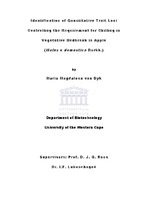| dc.description.abstract | The domesticated apple (Malus x domestica Borkh.) has been distributed into diverse climatic conditions worldwide for commercial production of fruit. Apple trees need exposure to cold temperatures, referred to as chill unit (CU) accumulation during winter, in order for budbreak to occur promptly and uniformly after winter. In warmer production areas the application of dormancy breaking chemicals has enabled successful production of high chilling requiring apple cultivars in suboptimal environmental conditions. In the Western Cape region of South Africa it is common orchard practice to apply dormancy breaking chemicals after winter in order to stimulate vegetative growth. If this is not done prolonged dormancy symptoms (PDS) are experienced which include extended rest, less synchronised breaking of buds and reduced branching. An increasing awareness of both global warming and the negative effects associated with the use of chemical sprays (for both pest and disease resistance and growth regulation) has resulted in the need to breed cultivars better adapted to current and future environmental conditions. The breeding of new cultivars using conventional breeding methods is a time consuming process, especially in perennial tree species with a long juvenile phase such as apple. The implementation of marker-assistedbreeding (MAB) and selection (MAS) will enable the selection of favourable genotypes at a very early seedling stage. Although markers linked to genes involved in disease resistance for a variety of known apple pathogens have been identified and are already in use in breeding programs, the genetic determinants of dormancy related characteristics residing within the bud itself (endodormancy) are poorly understood. This hampers the genetic improvement of such characters. Although this study focused on time of initial vegetative budbreak IVB, there are various other characteristics that can be associated with dormancy, such as position and number of budbreak and budbreak duration. The unravelling of the genetic basis of complex traits such as dormancy, can be done through the construction of a genetic linkage map followed by the identification of genomic regions, known as quantitative trait loci (QTL), that can be ssociated with the trait of interest. This study involved the construction of genetic linkage maps for two mapping pedigrees where the low chilling requiring cultivar ‘Anna’ was used as common male parent in crosses with the higher chilling requiring ‘Golden Delicious’ and ‘Sharpe’s Early’. A third mapping pedigree, with ‘Golden Delicious’ as female parent and ‘Prima’ as male parent, was also included. Maps consisted of transferable SSR markers only, facilitating the alignment with the proposed apple reference map (Silfverberg-Dilworth et al., 2006) and adherence to the common LG numbering system now being used for apple genetic linkage maps (Maliepaard et al., 1998). A number of newly developed EST-SSR markers are reported, some of which are candidates for filling large gaps between adjacent SSR markers on the apple reference map. An interactive database was developed to successfully manage the large amount of data generated during this investigation. A selective mapping, or bin mapping strategy (Vision et al., 2000) was developed for two of the three mapping populations in order to facilitate the incorporation and positioning of newly developed markers onto existing genetic linkage maps. This involves the screening of new markers on a small subset of the population, drastically reducing the cost and time involved. Genetic linkage maps constructed allowed for the detection of 18 putative QTLs affecting the time of IVB. Four of these QTLs co-localize with previously identified QTLs. A QTL identified on LG 8 confirms a previously
identified QTL (Segura et al., 2007), while one of the QTLs identified on LG 9
might coincide with a QTL identified on the corresponding LG 3 of the genetic
linkage map constructed by Conner et al. (1998). Two QTLs identified on
LG 10 might coincide with markers found to co-segregate with time of budbreak in an earlier study conducted by Lawson et al. (1995). An additional
14 QTLs involved in time of IVB have been identified. We proposed the testing of four markers in a validation study conducted on a second mapping pedigree derived from a cross between ‘Anna’ and ‘Golden Delicious’. These markers are CH04a12, CH04c06y, CH01h01 and A267. Not only do these markers show significant levels of association with the time of IVB, but segregation of parental alleles from the cultivar ‘Anna’ for two of these markers, CH04c06y and CH01h01, were found to be associated with the time of IVB in different genetic backgrounds. The identification of markers closely associated with time of IVB will facilitate the implementation of MAS in breeding programs in order to breed cultivars that are better adapted to local climatic conditions. | en_US |

